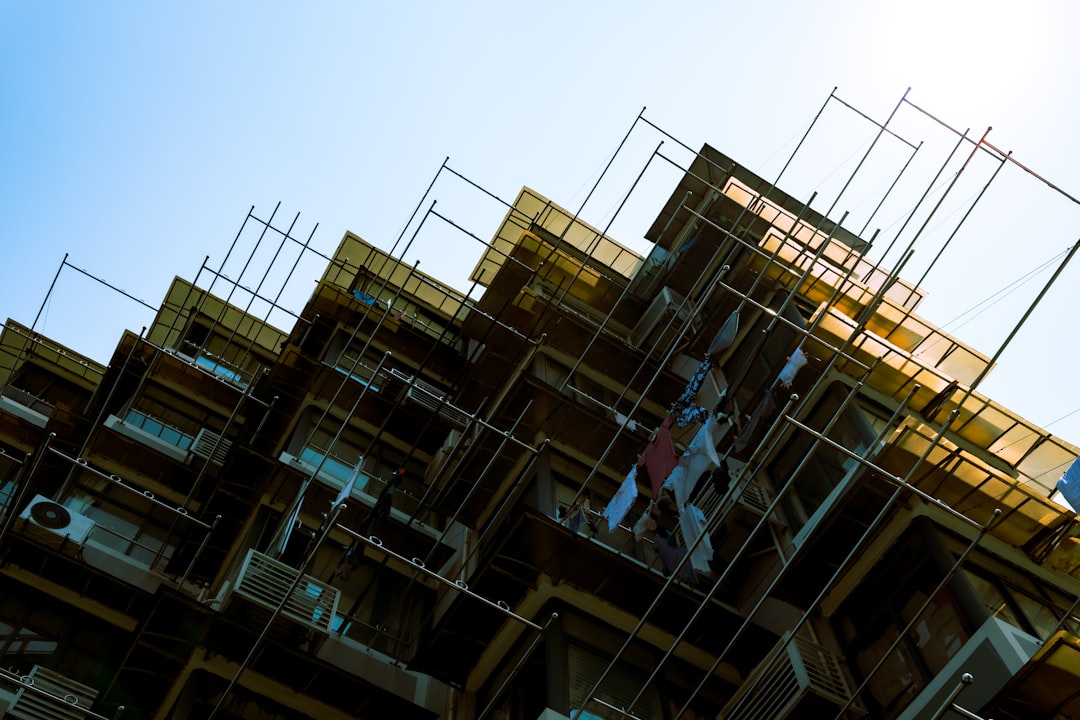

Engage prospects with a scan and streamline customer engagement with FREE QR code marketing tools by Sona – no strings attached!
Create a Free QR CodeFree consultation

No commitment

Engage prospects with a scan and streamline customer engagement with FREE QR code marketing tools by Sona – no strings attached!
Create a Free QR CodeFree consultation

No commitment
QR codes have evolved from novelty to strategic powerhouse, seamlessly bridging offline engagement with online action. For industrial property management services, leveraging QR codes introduces a fast, convenient, and data-driven way to enhance lead generation, improve tenant communication, and strengthen property marketing without requiring app downloads or complex technology stacks.
The shift toward digital and smart building technology has made it increasingly important to connect physical property assets with actionable data and streamlined workflows. Many property management teams still grapple with paper-based processes, sluggish response times to tenant requests, and the risk of missing potential leads who interact only with physical signage or handouts. This results in untracked prospects and missed opportunities. QR codes can play a transformative role by modernizing these workflows, automating tenant support, simplifying maintenance reporting, and turning every surface in a managed facility into a digital entry point for stakeholders.
Leveraging QR codes in industrial property management services opens up new opportunities to capture and nurture tenant and investor leads, reduce the lag between inquiry and engagement, boost operational efficiency, and deliver measurable ROI from every physical-to-digital interaction. When combined with a centralized platform like Sona QR and Sona, property teams can deploy, measure, and attribute QR-driven engagement at scale across portfolios.

In industrial property management, a common frustration is realizing that high-intent prospects who walk properties, browse posted signs, or view brochures are easily missed when their data never reaches your CRM. This gap leads to lost opportunities and a lack of timely follow-up. QR codes bridge these gaps by making physical touchpoints digitally actionable and measurable, ensuring tenants, vendors, and investors are never left untracked.
To replace slow analog processes, start by auditing where information currently dies on paper. Printed leasing forms can become QR-driven digital applications, manual sign-in sheets can become scannable visitor logs, and phone-only maintenance hotlines can be complemented by QR-triggered forms. Each replacement converts anonymous interest into attributed engagement that flows into your CRM or property management system for faster action. For easy setup, consider using Google Forms QR codes.
Here is how to do it effectively:
A centralized platform supports every step. From QR code generation to campaign deployment, tracking, and CRM integration, tools like Sona QR enable seamless reporting and growth without forcing teams into complicated new systems. The result is consistent lead capture across every site, shift, and property.

Industrial property managers often struggle with a lack of visibility when it comes to offline-to-online interactions. Many tenant and prospect journeys begin with physical signage, mailed brochures, or on-site property walkthroughs. Without a direct way to capture these moments, high-value leads slip through the cracks and response times lag. Over time this can result in potential tenants seeking faster-moving competitors and property teams remaining blind to emerging sales or maintenance needs. For context on performance impact, see how QR codes elevate commercial real estate marketing.
QR codes solve these frustrations by turning every touchpoint into an actionable digital gateway. They make it easy for someone to signal interest, request help, or learn more on the spot. The immediate payoff is shorter time to response and a reliable data trail that can be managed by marketing and operations alike.
Applied to common materials in this sector, the benefits compound. Lease signs, appointment cards, welcome packets, safety posters, vendor check-in desks, and direct mail inserts all become measurable. Over time, you will know exactly which assets drive tours, renewals, work orders, and investor inquiries.

Legacy property materials often lack digital integration, which makes it hard to connect offline actions to measurable outcomes. QR codes adapt to the diverse and fast-paced requirements of industrial portfolios by supporting multiple formats. Selecting the right format for each scenario ensures the action you want is the action users take.
Property teams find that certain QR formats pair naturally with their most frequent interactions. Forms streamline service requests and leasing inquiries. vCards help prospects and vendors save contacts without losing business cards. Wi-Fi access codes speed up connectivity for visitors and contractors. App downloads accelerate adoption of facility management tools where required by the operator.
Dynamic QR codes are particularly valuable because destinations can be edited, and engagement can be attributed at the campaign level. With Sona QR, property teams can generate any of these formats, change destinations without reprinting, segment by location or code, and view performance in a single dashboard.

Many industrial property teams underutilize high-intent onsite and print touchpoints, which means missed opportunities to capture interest and segment audiences. Foot traffic is often heavy around entryways, parking lots, loading docks, and common areas, yet there is no easy way to convert that activity into attributed leads or service signals.
By mapping the property journey, you can identify where scanners are most likely to take action. Each high-visibility surface can be transformed into a digital onramp that routes to the most relevant workflow, whether that is a tour booking, a request for proposal, or a maintenance ticket.
Place codes where prospects naturally pause or seek information. Segment scan data by placement and intent to prioritize follow-up and continuously refine channel strategy. Over time, you will see clear patterns that reveal where to invest in signage, creative, and field enablement.

Service workflows often break down due to slow manual processing, lack of early signal detection, or disconnected systems. This frustrates tenants, increases operational costs, and hides upsell opportunities from property operators. QR codes provide a direct path for action that can be automated from scan to resolution.
Start by aligning QR deployments to three core goals: capture demand for space, improve tenant experience, and streamline operations. The following use cases serve these goals and can be deployed quickly in most industrial settings without heavy technical overhead.
Each of these deployments builds a measurable engagement dataset. Over time, analysis of scan behavior reveals what tenants ask for most, which amenities drive lease extensions, and which marketing materials deliver the highest value.
A persistent challenge for industrial property marketers is building detailed, actionable audiences when high-fit prospects remain anonymous. Lack of segmentation and slow follow-up lets hot leads cool or move to a competitor. QR codes convert anonymous moments into identifiable, context-rich signals that flow into your CRM and ad platforms.
To make the most of these signals, plan your codes around the stages of your buyer and tenant journeys. Use distinct codes and destinations for awareness, consideration, and conversion moments. Then tag and segment each scan by use case, location, and timing so that outreach is immediate and relevant.
With Sona QR, each code becomes a smart entry point that captures the right attributes for retargeting and lifecycle marketing. For example, you can distinguish prospective tenants who scanned a brochure in the lobby from investors who scanned a financial highlights sheet at a conference, then tailor follow-up content accordingly.
Fragmented outreach leads to inconsistent messaging and lost attribution. QR codes unify your campaigns by linking physical surfaces and print collateral to digital experiences that are trackable in real time. This helps prospects and tenants move smoothly from curiosity to conversation to commitment.
In industrial property management, multi-channel consistency is especially important because interest often begins in the physical world. When a window sign, brochure, or dock poster connects to a tailored digital experience, you capture intent immediately and keep the journey moving with minimal friction.
QR codes serve as the offline onramp to your digital marketing engine. A centralized platform like Sona QR helps you manage all codes, monitor performance, and sync scan data with your CRM and ad platforms. The result is cohesive messaging, better attribution, and faster deal cycles.
Many industrial property teams struggle to move from pilot QR deployments to large-scale, optimized campaigns due to unclear process, weak analytics, or insufficient staff training. A simple, repeatable framework helps you scale what works while quickly iterating on placements or messages that underperform.
Use the following steps to plan and launch with confidence across your portfolio. Adapt the examples to your properties, then rely on analytics to refine performance over time.
Clarify the business outcome first. For example, you might want faster, traceable service ticketing via QR on equipment and doors so that tenants and staff can log issues immediately, preventing minor problems from escalating. Another objective could be capturing after-hours tour interest from window signage during an active leasing push.
Choose between static and dynamic QR codes. Static codes are fine for permanent assets like a property map PDF that rarely changes. Dynamic codes are best for anything you want to track, edit, or segment without reprinting.
A well-designed QR code improves scan rates and trust. Use high-contrast colors, add a frame or arrow to draw attention, and include a clear benefit-driven call to action like “Scan to book a tour” or “Scan to report an issue.”
Roll out codes to placements that align with your objectives. Focus on surfaces and materials that have both high visibility and clear intent, then expand to secondary locations once you validate performance.
Continuous measurement turns scans into outcomes. Use dashboards to see where scans happen, which devices are used, and how many convert. Then adjust design, placement, or destination to raise performance.
A robust platform underpins these steps. Start creating QR codes for free. Sona QR integrates with your CRM and workflows, surfaces engagement signals in real time, and reduces the chance of missed or delayed follow-ups. As results compound, you can standardize successful templates and expand with confidence.
Industrial property teams often face uncertainty about which touchpoints drive results. Without end-to-end tracking, it is difficult to know whether a brochure, fence sign, or lobby display is worth the spend. For strategy on connecting offline scans to outcomes, review Sona’s offline attribution guide. Tracking QR-driven engagement through to closed leases or resolved maintenance tickets is essential for budget optimization and process improvement.
Modern analytics reveal how each code performs by building, placement, and time of day. They also link scan behavior to downstream outcomes like tours, signed agreements, and satisfaction scores. With this visibility, you can invest in the channels and assets that consistently generate value and quickly adjust the ones that do not.
With Sona QR and Sona.com, you can go beyond scan counts. You can tie QR engagement to pipeline and revenue, validate which properties or campaigns deserve more budget, and prove the value of offline-to-online investments to leadership.
Scaling QR across a portfolio introduces complexity, from managing many codes to training field teams and ensuring accurate attribution. A few practical habits will raise scan rates, improve data quality, and make ROI clear in executive dashboards.
Start with the media you already use most often, such as window signage, lobby brochures, dock posters, and direct mail. Then build automation that routes each scan to the right person or service queue. The faster the follow-up, the more valuable the scan.
Creative deployments often deliver outsized results. For example, place a code on dock doors that launches a vendor check-in form in multiple languages, or add a QR code to monthly invoices that links to a renewal interest form and a direct line to the leasing team. These small touches create new lead sources without adding friction.
Industrial property managers have long grappled with the challenge of surfacing the right engagement signals at the right time, from tracking anonymous tenant interest to accelerating follow-up with hot leads and spotting upsell cues. QR codes now power a practical solution by turning every physical surface into a digital entry point. Properties gain the ability to capture intent, reduce service delays, and deliver a cohesive tenant and investor experience without requiring an app.
Strategically placed QR codes not only boost engagement across property touchpoints, they also provide the trackability and segmentation needed to nurture audiences throughout the funnel. When these signals flow into your CRM and property systems, every scan contributes to smarter follow-up, tighter attribution, and measurable revenue impact. Over time, your portfolio becomes a connected network of digital triggers that move prospects and tenants toward the next best action.
Industrial property management services are evolving quickly, and QR codes sit at the heart of that transformation. They combat missed leads, reveal anonymous demand, and automate service workflows across complex sites. By adopting dynamic QR campaigns, seamless CRM integration, and actionable analytics with platforms like Sona QR and Sona, property leaders can amplify lead capture, drive operational excellence, and maximize asset value in today’s competitive market.
QR codes have transformed industrial property management services from traditional, limited outreach into dynamic, measurable lead generation channels. Whether it’s capturing qualified tenant inquiries, streamlining property tours, or delivering tailored information instantly, QR codes replace manual processes with seamless, mobile-friendly actions that capture real-time engagement data—turning every touchpoint into a high-conversion opportunity.
Imagine instantly knowing which properties or marketing materials attract the most interest and being able to update listings or offers on the fly without costly reprints. With Sona QR, you can create dynamic, trackable QR codes in seconds, monitor scan activity in real time, and connect each interaction directly to your lead pipeline. No missed leads, no wasted resources—just smarter, more efficient property management campaigns.
Start for free with Sona QR today and turn every scan into a new prospect, a scheduled visit, or a signed lease.
Industrial property management companies provide services including tenant communication, maintenance request management, vendor onboarding and compliance, tenant onboarding and renewals, emergency and safety communications, and lead generation through digital engagement tools like QR codes.
Improving tenant communication and satisfaction can be achieved by leveraging QR codes to enable fast, convenient maintenance requests, provide real-time updates, automate tenant support workflows, and deliver immediate confirmations, which reduce response times and improve service quality.
Best practices include deploying QR codes on equipment and asset labels to allow tenants and staff to submit detailed maintenance requests with photos and urgency levels, enabling faster repair cycles, reducing misrouted tickets, and ensuring better service level adherence.
Increase visibility and appeal by placing QR codes on leasing signage, brochures, and window signs that link to virtual tours, availability lists, and booking forms, allowing prospects to engage instantly and property teams to capture qualified leads with context.
Innovative technologies include dynamic QR codes that connect offline touchpoints to digital forms, virtual tours, maintenance requests, vendor check-ins, and tenant portals, integrated with centralized platforms like Sona QR for tracking, analytics, CRM integration, and automated follow-up.
Use Sona QR's trackable codes to improve customer acquisition and engagement today.
Create Your FREE Trackable QR Code in SecondsJoin results-focused teams combining Sona Platform automation with advanced Google Ads strategies to scale lead generation

Connect your existing CRM

Free Account Enrichment

No setup fees
No commitment required

Free consultation

Get a custom Google Ads roadmap for your business






Launch campaigns that generate qualified leads in 30 days or less.
